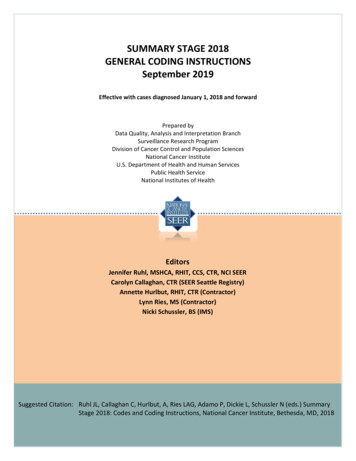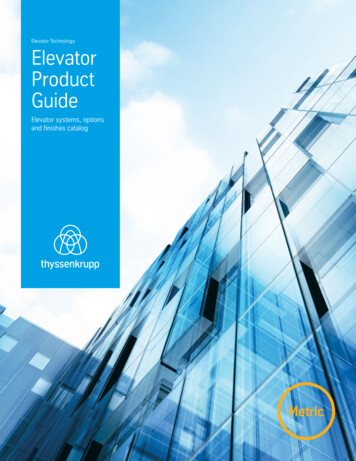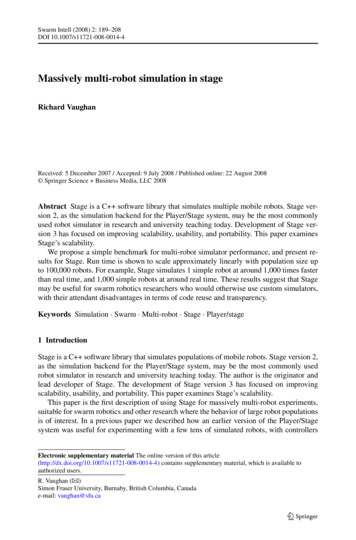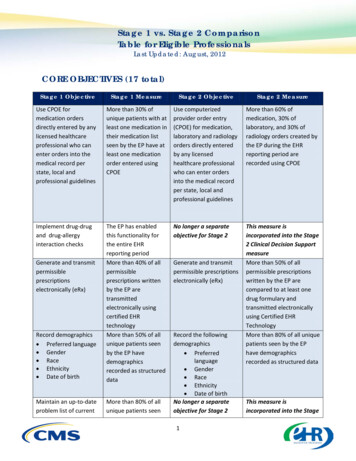
Transcription
SUMMARY STAGE 2018GENERAL CODING INSTRUCTIONSSeptember 2019Effective with cases diagnosed January 1, 2018 and forwardPrepared byData Quality, Analysis and Interpretation BranchSurveillance Research ProgramDivision of Cancer Control and Population SciencesNational Cancer InstituteU.S. Department of Health and Human ServicesPublic Health ServiceNational Institutes of HealthEditorsJennifer Ruhl, MSHCA, RHIT, CCS, CTR, NCI SEERCarolyn Callaghan, CTR (SEER Seattle Registry)Annette Hurlbut, RHIT, CTR (Contractor)Lynn Ries, MS (Contractor)Nicki Schussler, BS (IMS)Suggested Citation: Ruhl JL, Callaghan C, Hurlbut, A, Ries LAG, Adamo P, Dickie L, Schussler N (eds.) SummaryStage 2018: Codes and Coding Instructions, National Cancer Institute, Bethesda, MD, 2018
NCI SEERPeggy Adamo, BS, AAS, RHIT, CTRLois Dickie, CTRSerban Negoita, MD, PhD, CTROthersBethany Fotumale, BS, CTR (SEER Utah Registry)Jennifer Hafterson, CTR (SEER Seattle Registry)Denise Harrison, BS, CTR (Santa Barbara City College)Stephanie M. Hill, MPH, CTR (SEER New Jersey Registry)Loretta Huston, BS, CTR (SEER Utah Registry)Tiffany Janes, CTR (SEER Seattle Registry)Bobbi Jo Matt, BS, RHIT, CTR (SEER Iowa Registry)Mary Mroszczyk, CTR (Massachusetts Registry)Patrick Nicolin, BA, CTR (SEER Detroit Registry)Lisa A. Pareti, BS, RHIT, CTR (SEER Louisiana Tumor Registry)Cathryn Phillips, BA, CTR (SEER Connecticut Registry)Mary Potts, RHIA, CPA, CTR (SEER Seattle Registry)Elizabeth (Liz) Ramirez-Valdez, CTR (SEER New Mexico Registry)Nancy Rold, CTR (Missouri Registry)Debbi Romney, CTR (SEER Utah Registry)Winny Roshala, BA CTR (SEER Greater California Registry)Christina Schwarz, CTR (SEER Greater Bay Area Cancer Registry)Kacey Wigren, RHIT, CTR (SEER Utah Registry)Copyright information:All material in this report may be reproduced or copied without permission; citation as to source,however, is appreciated.September 2019Summary Stage 2018 Coding Manual v1.72
We would also like to give a special thanks to the following individuals at Information Management Services, Inc.(IMS) who provide us with document support and web development.Suzanne Adams, BS, CTRGinger Carter, BAMichael Coffey, BSJean Cyr, BABran Handley, BSCharles May, BSSeptember 2019Summary Stage 2018 Coding Manual v1.73
Publication HistoryThe original 2-digit Historic Coding was prepared for the National Cancer Institute End Results Group by anExtent of Disease Advisory Group. While this code had been in use since the early 1950s, it was not printed as aformal document until 1967.The 1977 Summary Staging Guide was prepared by the Demographic Analysis Section of the National CancerInstitute and was edited by Evelyn M. Shambaugh and Mildred A. Weiss. This manual has been reprintednumerous times in the ensuing years.The Summary Staging Guide 2000 (SS2000) was a follow-on to the two previous staging versions, Summary Stage1977 and historic stage. SS2000 updated medical terminology and newer concepts of stage. In order todocument the SS2000 changes, footnotes designated terms that changed their stage designation and what theywould have been in the two previous versions.September 2019Summary Stage 2018 Coding Manual v1.74
Table of ContentsSUMMARY STAGE9GUIDELINES BY STAGE10CODE 0: IN SITU10CODE 1: LOCALIZED11REGIONAL STAGE: CODES 2-412CODE 2: REGIONAL BY DIRECT EXTENSION ONLY13CODE 3: REGIONAL LYMPH NODES ONLY14CODE 4: REGIONAL BY BOTH DIRECT EXTENSION AND REGIONAL LYMPH NODE INVOLVED17CODE 7: DISTANT18CODE 8: BENIGN/BORDERLINE19CODE 9: UNKNOWN IF EXTENSION OR METASTASIS20GENERAL INSTRUCTIONS FOR USING THE SUMMARY STAGE 2018 MANUAL21GUIDELINES FOR SUMMARY STAGE23HOW TO ASSIGN SUMMARY STAGE25DEFINITIONS OF TERMS USED IN THIS MANUAL26AMBIGUOUS TERMINOLOGY28SUMMARY STAGE 2018 CHAPTERS30HEAD AND NECK35DEFINITION OF ANATOMIC SITES WITHIN THE HEAD AND NECK35REGIONAL LYMPH NODES FOR HEAD AND NECK PRIMARIES39DISTINGUISHING “IN SITU” AND “LOCALIZED” TUMORS FOR LIP, ORAL CAVITY, AND PHARYNX40CERVICAL LYMPH NODES AND UNKNOWN PRIMARY TUMORS OF HEAD AND NECK42LIP46TONGUE ANTERIOR50GUM54FLOOR OF MOUTH58PALATE HARD62BUCCAL MUCOSA66MOUTH OTHER70MAJOR SALIVARY YNX OTHER91MIDDLE EAR94NASAL CAVITY AND PARANASAL SINUSES97September 2019Summary Stage 2018 Coding Manual v1.75
SINUS OTHER102LARYNX SUPRAGLOTTIC105LARYNX GLOTTIC109LARYNX SUBGLOTTIC113LARYNX OTHER117MELANOMA HEAD AND NECK121DIGESTIVE AND HEPATOBILIARY SYSTEMS124DIGESTIVE SYSTEM SITES124DISTINGUISHING “IN SITU” AND “LOCALIZED” TUMORS FOR THE DIGESTIVE SYSTEM126ESOPHAGUS127STOMACH134SMALL INTESTINE138APPENDIX142COLON AND RECTUM145ANUS152LIVER155INTRAHEPATIC BILE DUCTS158GALLBLADDER161EXTRAHEPATIC BILE DUCTS164AMPULLA OF VATER167BILIARY OTHER170PANCREAS172DIGESTIVE OTHER176RESPIRATORY TRACT AND THORAX178TRACHEA179THYMUS181LUNG183PLEURAL MESOTHELIOMA188RESPIRATORY OTHER191BONE194SOFT TISSUE197GASTROINTESTINAL TUMORS197HEART, MEDIASTINUM AND PLEURA199RETROPERITONEUM202SOFT TISSUES AND SARCOMAS205SKIN209RELATIONSHIP BETWEEN THICKNESS, DEPTH OF INVASION, AND CLARK LEVEL209SKIN210September 2019Summary Stage 2018 Coding Manual v1.76
KAPOSI SARCOMA214MERKEL CELL SKIN216MELANOMA SKIN220BREAST225FEMALE GENITAL SYSTEM229VULVA229VAGINA232CERVIX235CORPUS UTERI238CORPUS CARCINOMA AND CARCINOSARCOMA239CORPUS SARCOMA242OVARY AND PRIMARY PERITONEAL CARCINOMA245FALLOPIAN TUBE249ADNEXA UTERINE OTHER253GENITAL FEMALE OTHER255PLACENTA257MALE GENITAL SYSTEM260PENIS260PROSTATE263TESTIS266GENITAL MALE OTHER269URINARY SYSTEM271BLADDER, RENAL PELVIS AND URETERS ANATOMIC STRUCTURES271KIDNEY272KIDNEY RENAL PELVIS275DISTINGUISHING NONINVASIVE AND INVASIVE BLADDER CANCER278BLADDER279URETHRA283URINARY OTHER285OPHTHALMIC SITES287SKIN EYELID287CONJUNCTIVA290MELANOMA CONJUNCTIVA292MELANOMA UVEA294RETINOBLASTOMA296LACRIMAL GLAND/SAC299ORBITAL SARCOMA301LYMPHOMA OCULAR ADNEXA303September 2019Summary Stage 2018 Coding Manual v1.77
EYE OTHER305BRAIN307BRAIN307CNS OTHER311INTRACRANIAL GLAND313ENDOCRINE SYSTEM315THYROID315PARATHYROID319ADRENAL GLAND322ENDOCRINE OTHER324HEMATOLOGIC MALIGNANCIES326LYMPH NODES AND LYMPHATIC STRUCTURES ABOVE AND BELOW THE DIAPHRAGM326LYMPHOMA327MYCOSIS FUNGOIDES330PRIMARY CUTANEOUS LYMPHOMAS332MYELOMA AND PLASMA CELL DISORDERS334HEMERETIC336ILL-DEFINED OTHER339APPENDIX I: LYMPH NODE/LYMPH NODE CHAIN REFERENCE TABLE341APPENDIX II: SS2018 CHAPTERS SOLID TUMORS350APPENDIX III: SS2018 CHAPTERS HEMATOPOIETIC AND LYMPHOID NEOPLASMS365September 2019Summary Stage 2018 Coding Manual v1.78
SUMMARY STAGESummary Stage is the most basic way of categorizing how far a cancer has spread from its point oforigin. Historically, Summary Stage has also been called General Stage, California Stage, historic stage, and SEERStage.The 2018 version of Summary Stage applies to every site and/or histology combination, including lymphomasand leukemias.Summary Stage uses all information available in the medical record; in other words, it is a combination of themost precise clinical and pathological documentation of the extent of disease. Many central registries reporttheir data by Summary Stage as the staging categories are broad enough to measure the success of cancercontrol efforts and other epidemiologic efforts.There are six main categories in Summary Stage, each of which is discussed in detail. In addition, the maincategory of Regional stage is subcategorized by the method of spread. The code structure is:Code01234789DefinitionIn situLocalized onlyRegional by direct extension onlyRegional lymph nodes onlyRegional by BOTH direct extension AND lymph node involvementDistant site(s)/node(s) involvedBenign/borderline*Unknown if extension or metastasis (unstaged, unknown, or unspecified)Death certificate only case*Applicable for the following SS2018 chapters: Brain, CNS Other, Intracranial GlandNote: For SS2018, code 5 for “Regional, NOS” can no longer be coded. Code 5 (Regional, NOS) is still applicablefor SS2000.September 2019Summary Stage 2018 Coding Manual v1.79
GUIDELINES BY STAGECode 0: In situNote: ALWAYS check site-specific SS2018 chapters for exceptions and/or additional information1. In situ means “in place”. The technical definition of in situ is the presence of malignant cells within thecell group from which they arose. There is no penetration of the basement membrane of the tissue andno stromal invasion. Generally, a cancer begins in the rapidly dividing cells of the epithelium or lining ofan organ and grows from the inside to the outside of the organ. An in situ cancer fulfills all pathologicalcriteria for malignancy except that it has not invaded the supporting structure of the organ or tissue inwhich it arose.Note: If the pathology report indicates an in situ tumor but there is evidence of positive lymph nodes ordistant metastases, code to the regional nodes/distant metastases.2. An in situ diagnosis can only be made microscopically, because a pathologist must identify thebasement membrane and determine that it has not been penetrated. If the basement membrane hasbeen disrupted (in other words, the pathologist describes the tumor as microinvasive, microinvasion),the case is no longer in situ and is at least localized (code 1).3. Pathologists have many ways of describing in situ cancer Intracystic Intra-epithelial No penetration below the basement membrane No stromal invasion Non-infiltrating Noninvasive Pre-invasive4. Organs and tissues that have no epithelial layer cannot be staged as in situ, since they do not have abasement membrane.5. Code 0 is not applicable for the following Summary Stage chapters BoneBrainCervical Lymph Nodes, Occult Head andNeckCNS OtherCorpus SarcomaHeart, Mediastinum and PleuraHemeReticIll-defined otherKaposi SarcomaSeptember 2019 LymphomaLymphoma Ocular AdnexaMycosis FungoidesMyeloma Plasma Cell DisorderPleural MesotheliomaPrimary Cutaneous Lymphoma (non-MFand SS)RetinoblastomaRetroperitoneumSoft TissueSummary Stage 2018 Coding Manual v1.710
Code 1: LocalizedNote: ALWAYS check site-specific SS2018 chapters for exceptions and/or additional information1. A localized cancer is defined asa. Malignancy limited to the site of originb. Spread no farther than the site of origin in which it startedc. Infiltration past the basement membrane of the epithelium into parenchyma (the functionalpart of the organ), but there is no spread beyond the boundaries of the organNote: A tumor can be widely invasive or even show metastases within the organ itself and still be“confined to organ of origin” or localized in Summary Stage.2. For organs that have definite boundaries (such as prostate, testis, or stomach) or sites where there is aclear line between the organ of origin and the surrounding region (such as breast or bladder), it isusually straightforward to determine if the cancer is localized.a. An exception is skin, because it is sometimes difficult to determine where the dermis ends andsubcutaneous tissue begins.b. For many internal organs, it is difficult to determine whether the tumor is localized withoutsurgery; however, with the increasing sophistication of imaging, it may be possible to determinewhether a cancer is localized or regional without surgery.3. It is important to know and recognize the names of different structures within the organ (such as laminapropria, myometrium, muscularis) so that a description of invasion or involvement of these structureswill not be interpreted inappropriately, which may lead to over-staging.4. Because Summary Stage uses both clinical and pathological information, it is important to review andread the pathology and operative report(s) for comments on gross evidence of spread, microscopicextension and metastases, as well as physical exam and diagnostic imaging reports for mention ofregional or distant disease.a. If any of these reports provides evidence that the cancer has spread beyond the boundaries ofthe organ of origin, the case is not localized.b. If the pathology report, operative report and other investigations show no evidence of spread,the tumor may be assumed to be localized.5. Code 1 is not applicable for the following Summary Stage chapters: Cervical Lymph Nodes and Unknown Primary Ill-defined otherSeptember 2019Summary Stage 2018 Coding Manual v1.711
Regional Stage: Codes 2-4There are several codes to describe the different methods of regional spread of tumor.Code234DefinitionRegional by direct extension onlyRegional lymph node(s) involved onlyRegional by BOTH direct extension AND regional lymph node(s) involvedClinicians may use some terms differently than cancer registrars. Therefore, it is important to understand thewords used to describe the spread of the cancer and how they are used in staging. For example:1. “Local” as in “carcinoma of the stomach with involvement of the local lymph nodes.” Local nodes arethe first group of nodes to drain the primary site and often are referred to as “regional” nodes. Unlessevidence of distant or regional spread is present, such a case should be staged as regional, lymphnode(s) involved only, assign 3.2. “Metastases” as in “carcinoma of lung with peribronchial lymph node metastases”. Metastases in thissense means involvement by tumor. The name of the involved lymph node will determine whether it is aregional node or distant node. In this case, it would be a regional node. It is important to learn thenames of regional nodes for each primary site.September 2019Summary Stage 2018 Coding Manual v1.712
Code 2: Regional by direct extension onlyNote: ALWAYS check site-specific SS2018 chapters for exceptions and/or additional information1. Regional stage by direct extension is perhaps the broadest category as well as the most difficult toproperly identify. The brief definition is direct tumor extension beyond the limits of the site of origin.Although the boundary between localized and regional tumor extension is usually well-identified, theboundary between regional and distant spread is not always clear and can be defined differently byphysicians in various specialties.2. Cancer becomes regional by direct extension when there is potential for spread by more than onevascular supply route. For example, if the tumor goes outside of the wall and invades another organ, itregional by direct extension.3. The formal (scientific) definition of regional used by surgeons is that area extending from the peripheryof an involved organ that lends itself to removal en bloc with a portion of, or an entire organ with outerlimits to include at least the first level nodal basin. However, en bloc resection (removal of multipleorgans or tissues in one piece at the same time) is not always feasible or may have been shown not tobe necessary. For example, many clinical trials have shown that lumpectomy or modified radicalmastectomy has equivalent survival to the very disfiguring radical mastectomy for treatment of breastcancer.4. In contrast, radiation oncologists define the term regional as including any organs or tissuesencompassed in the radiation field used to treat the primary site and regional lymph nodes.5. For primary sites that have “walls” (e.g. colon, rectum), regional by direct extension is invasion throughentire wall of organ into surrounding organs and/or adjacent tissues, direct extension or contiguousspread. For those primary sites without defined walls, regional by direct extension is when the tumorhas spread beyond the primary site or capsule into adjacent structures.6. Do NOT use code 2 if there is direct extension and also regional nodes positive (see code 4).7. Code 2 is not applicable for the following Summary Stage chapters: Cervical Lymph Nodes and Unknown Primary HemeRetic Ill-defined other Myeloma Plasma Cell DisorderSeptember 2019Summary Stage 2018 Coding Manual v1.713
Code 3: Regional lymph nodes onlyNote: ALWAYS check site-specific SS2018 chapters for exceptions and/or additional information1. Regional lymph nodes are listed for each chapter/site.a. If a lymph node chain is not listed in code 3, then the following resources can be used to help identifyregional lymph nodes:i.Appendix Iii. Anatomy textbookiii. ICD-O manualiv. Medical dictionary (synonym)2. If no preoperative treatment was administered and there is a discrepancy between clinical information andpathological information about the same lymph nodes, pathological information takes precedence. It is notnecessary to biopsy every lymph node in the suspicious area to disprove involvement. Use the followingpriority order:a. Pathology reportb. Imagingi.If nodes are determined positive based on imaging and then confirmed to be negative onpathological exam, treat the regional nodes as negative when assigning Summary Stagec. Physical exami.If nodes are determined positive based on physical exam and then confirmed to be negative onpathological exam, treat the regional nodes as negative when assigning Summary Stage3. If the patient receives neoadjuvant (preoperative) systemic therapy (chemotherapy, immunotherapy) orradiation therapy, code the clinical information if that is the most extensive lymph node involvementdocumented. If the post-neoadjuvant surgery shows more extensive lymph node involvement, code theregional nodes based on the post-neoadjuvant information.4. For solid tumors, the terms “fixed” or “matted” and “mass in the hilum, mediastinum, retroperitoneum,and/or mesentery” (with no specific information as to tissue involved) are recorded as involvement oflymph nodes.a. Other terms, such as “palpable,” “enlarged,” “visible swelling,” “shotty,” or “lymphadenopathy”should be ignored for solid tumors. If these terms are used and there is no treatment toindicate lymph node involvement, treat the case as having no lymph node involvement.5. The terms “homolateral,” “ipsilateral,” and “same side” are used interchangeably.September 2019Summary Stage 2018 Coding Manual v1.714
6. Accessible lymph nodes: For “accessible” lymph nodes that can be observed, palpated, or examinedwithout instruments, such as the regional nodes for the breast, oral cavity, salivary gland, skin, thyroid,and other organs, look for some description of the regional lymph nodes. A statement such as“remainder of examination negative” is sufficient to determine negative regional lymph nodes.7. Inaccessible lymph nodes: For certain primary sites, regional lymph nodes are not easily examined bypalpation, observation, physical examination, or other clinical methods. These are lymph nodes withinbody cavities that in most situations cannot be palpated, making them inaccessible. Bladder, colon,corpus uteri, esophagus, kidney, liver, lung, ovary, prostate, and stomach are examples of inaccessiblesites (this is not an all-inclusive list). When the tumor is Localized and standard treatment for a localizedsite is done, it is sufficient to determine negative regional lymph nodes.8. Involved nodes found during sentinel lymph node procedures are classified as positive regional nodes.a. The sentinel lymph node is the first lymph node to receive lymphatic drainage from a primarytumor.b. If it contains metastatic tumor, this indicates that other lymph nodes may contain tumor. If itdoes not contain metastatic tumor, other lymph nodes are not likely to contain tumor.Occasionally there is more than one sentinel lymph node9. For some chapters, ITCs are counted as positive regional nodes, while other chapters count them asnegative. See the individual chapters to determine how to count ITCs.10. Discontinuous (satellite) tumor deposits (peritumoral nodules) for colon, appendix, rectosigmoid andrectum can occur WITH or WITHOUT regional lymph node involvement. Assign the appropriate codeaccording to guidelines in individual chapters. Tumor nodules in pericolic or perirectal fat withoutevidence of residual lymph node structures can be one of several aspects of the primary cancer:discontinuous spread, venous invasion with extravascular spread, or a totally replaced lymph node. Ifthere are Tumor Deposits AND node involvement, code only the information on node involvement inSummary Stage.11. If direct extension of the primary tumor into a regional lymph node is shown, code as involved regionalnodes.12. Any positive unidentified nodes included with the resected primary site specimen are to be coded as“Regional Lymph Nodes, NOS”.13. If the only indication of positive regional lymph node involvement in the record is the physician’sstatement of a positive N category from the TNM staging system or a stage from a site-specific stagingsystem, use that information to code regional lymph node involvement.14. If a specific chain of lymph nodes is named, but not listed as regional, first determine if the name issynonymous with a listed lymph node. Otherwise, assume distant lymph node(s) are involved.September 2019Summary Stage 2018 Coding Manual v1.715
15. Code 3 is not applicable for the following Summary Stage chapters: Brain CNS Other HemeRetic Ill-defined other (includes unknown primary site, C809) Intracranial Gland Lymphomao Primary Cutaneous Lymphoma and Ocular Adnexal Lymphoma have separate chapters fromLymphoma and regional lymph node involvement is assigned in these chapters.16. Do NOT use code 3 if there are regional nodes positive AND also direct extension (see code 4).September 2019Summary Stage 2018 Coding Manual v1.716
Code 4: Regional by BOTH direct extension AND regional lymph node(s) involvedNote: ALWAYS check site-specific SS2018 chapters for exceptions and/or additional information1. For tumors that are regional (see definition of code 2) and have regional lymph node involvement (seedefinition of code 3), use code 4.2. If there is only localized involvement (see definition of code 1) with regional lymph node involvement,assign code 3.3. Code 4 is not applicable for the following Summary Stage chapters: Brain Cervical Lymph Nodes and Unknown Primary CNS Other HemeRetic Ill-defined other (includes unknown primary site) Intracranial Gland Lymphomao Primary Cutaneous Lymphoma and Ocular Adnexal Lymphoma have separate chapters fromLymphoma and regional lymph node involvement is assigned in these chapters. Myeloma Plasma Cell DisorderSeptember 2019Summary Stage 2018 Coding Manual v1.717
Code 7: DistantNote: ALWAYS check site-specific SS2018 chapters for exceptions and/or additional information1. Distant metastases are tumor cells that have broken away from the primary tumor, have travelled to otherparts of the body, and have begun to grow at the new location. Distant stage is also called remote, diffuse,disseminated, metastatic, or secondary disease. The point is that in most cases there is no visible continuoustrail of tumor cells involving only the primary site and the distant site.2. Cancer cells can travel from the primary site in any of four ways.a. Extension from primary organ beyond adjacent tissue into next organ; for example, from the lungthrough the pleura into bone or nerveb. Travel in lymph channels beyond the first (regional) drainage area. Tumor cells can be filtered, trappedand begin to grow in any lymph nodes in the body.c. Hematogenous or blood-borne metastases. Invasion of blood vessels within the primary tumor (veinsare more susceptible to invasion than thicker-walled arteries) allows escape of tumor cells or tumoremboli which are transported through the blood stream to another part of the body where it lodges in acapillary or arteriole. At that point, the tumor penetrates the vessel wall and grows back into thesurrounding tissue.d. Spread through fluids in a body cavity.i. Example: malignant cells rupture the surface of the primary tumor and are released into the thoracicor peritoneal cavity. They float in the fluid and can land and grow on any tissue reached by the fluid.ii. This type of spread is also called implantation or seeding metastases. Some tumors form largequantities of fluid called ascites that can be removed, but the fluid rapidly re-accumulates. However,the presence of fluid or ascites does not automatically indicate dissemination. There must becytologic evidence of malignant cells. A subsequent clinical diagnosis should be able to override anegative cytology. Malignant cells in ascites or peritoneal washings may not be distant involvementin some schemas.3. Common sites of distant spread are liver, lung, brain, and bones, but they are not listed specifically for eachchapter. These organs receive blood flow from all parts of body and thus are a target for distant metastases.However, if the primary site is adjacent to the liver, lung, brain or bone, it is important to review theSummary Stage chapter for the primary site to assure that the stage is not regional by direct extension.a. Example: Liver involvement from a primary in the gallbladder. It is likely that this is regional by directextension rather than distant stage, since the gallbladder is adjacent to the liver.4. Read the diagnostic imaging reports to determine whether the cancer involves the surface of the secondaryorgan, which could either be regional by direct (contiguous) extension or distant (if determined to be adiscontiguous surface implant). If the tumor is identified growing from one organ onto/through the surfaceof the secondary organ, then it is contiguous extension. But if the tumor is only found in the parenchyma ofthe secondary organ well away from the primary organ, then it is discontinuous mets.5. Hematopoietic, immunoproliferative, and myeloproliferative neoplasms are distant except as noted in theSummary Stage chapter.6. Code 7 is not applicable for the following Summary Stage chapters: Ill-defined otherSeptember 2019Summary Stage 2018 Coding Manual v1.718
Code 8: Benign/Borderline1. Code 8 is for Benign/borderline neoplasms. Benign/borderline neoplasms are collected ONLY for thefollowing chapters: BrainCNS OtherIntracranial Gland2. If a registry collects other benign/borderline tumors that are not reportable, use code 9 for Summary Stage2018. Code 8, at this time, will not be allowed for other sites.September 2019Summary Stage 2018 Coding Manual v1.719
Code 9: Unknown if extension or metastasis (unstaged, unknown or unspecified)Note: ALWAYS check site-specific SS2018 chapters for exceptions and/or additional information1. If the primary site is unknown (C809), then Summary Stage must be unknown.2. Assign 9 very sparingly. If possible, contact the physician to see if there is more information about the casewhich is not in the record, such as diagnostic studies performed prior to admission or documentation in thephysician’s office record.3. There will be cases for which sufficient evidence is not available to adequately assign a stage. Examplesinclude:a. The patient expires before workup is completedb. A patient refuses a diagnostic or treatment procedurec. There is limited workup due to the patient’s age or a simultaneous comorbid or contraindicatingconditiond. Only a biopsy is done and does not provide enough information to assign stage4. Code 9 is to be used by default for Death Certificate Only (DCO) cases; however, assign the appropriateSummary Stage when specific staging information is available on a DCO.September 2019Summary Stage 2018 Coding Manual v1.720
GENERAL INSTRUCTIONS FOR USING THE SUMMARY STAGE2018 MANUALThe 2018 Summary Stage Manual chapters consist of a one-digit hierarchical code. In the United States, thesechapters will apply to January 1, 2018 diagnoses and forward. It is extremely important to thoroughly read allclinical and pathological documentation, including imaging studies, operative and pathology reports, and theclinician’s narrative descriptions of tumor involvement.1. Updates to the Summary Stage 2018 manual were based on the AJCC 8th edition. Although the twosystems are similar, there are many differences between them. For example, something that is regionalin AJCC (recorded in T or N) may be distant in Summary Stage. If a structure or lymph node cannot befound in localized (code 1) or regional (codes 2-4), then review distant (code 7).2. Summary Stage chapters apply to ALL primary sites and histologies. Most chapters are based on primarysite, while some are based on histology alone, or both primary site and histology.3. Chapter-specific guidelines take precedence over general guidelines. Always read the informationpertaining to a specific primary site or histology chapter.4. For ALL primary sites and histologies, Summary Stage is based on a combined clinical andoperative/pathological assessment. Gross observations at surgery are particularly important when allmalignant tissue cannot be, or was not, removed.a. In the event of a discrepancy between pathology and operative reports concerning excisedtissue, priority is given to the pathology report5. Summary Stage should include all information available within four months of diagnosis in the absenceof disease progression or upon completion of surgery(ies) in first course of treatment, whichever islonger.6. Clinical information, such as description of skin involvement for breast cancer and distant lymph nodesfor any site, can change the Summary Stage. Be sure to review the clinical information carefully toaccurately determine the extent of disease.a. If the operative/pathology information disproves the clinical information, use theoperative/pathology information.7. When multiple tumors are reported as a single primary, assign the greatest Summary Stage from anytumor.8. Information for Summary Stage from a surgical resection after neoadjuvant treatment may be used,but ONLY if the extent of disease is greater than the pre-treatment clinical findings.9. Disease progression, including metastatic involvement, known to have developed after the initial stageworkup, should be excluded when assigning Summary Stage.10. Autopsy reports are used in Summary Stage just as are pathology reports, applying the same rules forinclusion and exclusion.Septem
GENERAL CODING INSTRUCTIONS . September 2019 . Effective with cases diagnosed January 1, 2018 and forward . . BS, CTR (Santa Barbara City College) Stephanie M. Hill, MPH, CTR (SEER New Jersey Registry) Loretta Huston, BS, CTR (SEER Utah Registry) . Summary Stage uses all information available in the medical record; in other words, it is a .











